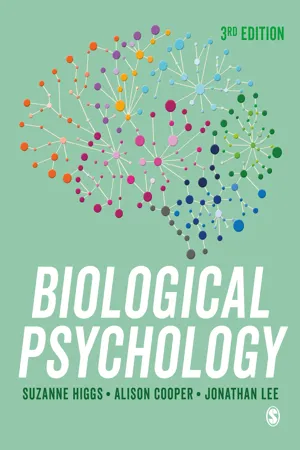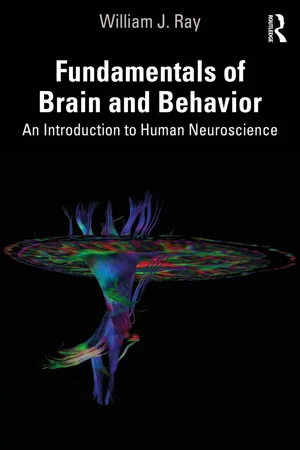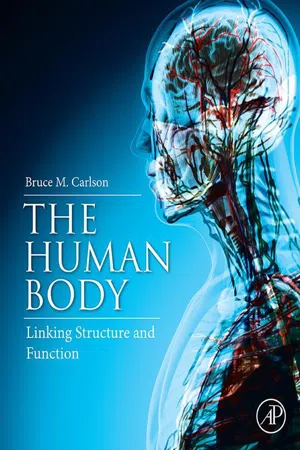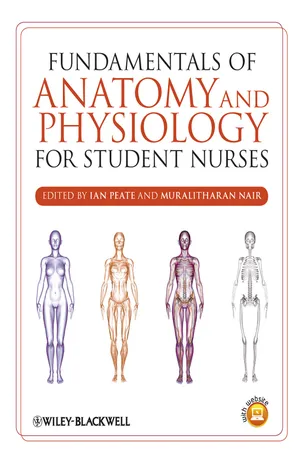Biological Sciences
Nervous Coordination
Nervous coordination refers to the process by which the nervous system transmits and integrates information to regulate and coordinate the activities of different parts of the body. This involves the transmission of electrical impulses along nerve cells and the release of chemical messengers called neurotransmitters. Nervous coordination plays a crucial role in controlling movement, sensation, and other physiological functions.
Written by Perlego with AI-assistance
Related key terms
9 Key excerpts on "Nervous Coordination"
- eBook - ePub
- Azhar ul Haque Sario, Azhar ul Haque Sario(Authors)
- 2023(Publication Date)
- tredition(Publisher)
Coordination and controlMammalian nervous systemThe nervous system, encompassing the brain, spinal cord, and a myriad of nerves, functions as the supreme command center of our bodies. Picture it as an ultramodern control room, deftly managing a wide array of tasks with remarkable coordination.At the center of this intricate system lies the brain, nature's masterpiece, acting as the top boss of our body. It decodes messages from our senses, processes our thoughts, and guides our emotions, much like an advanced computer that constantly sifts through and reacts to incoming information.The spinal cord serves as a crucial link, akin to a highspeed expressway, ferrying messages to and fro between the brain and the rest of the body. Imagine it as the primary communication line, carrying essential messages rapidly and effectively, ensuring our actions and responses are prompt and precise.Then, there are the nerves, spreading out like an extensive network. These are the diligent couriers of the system, transmitting essential signals throughout the body. They ensure everything, from a simple blink to the steady rhythm of the heart, is impeccably synchronized. They resemble tireless messengers, relaying information constantly to maintain the body's smooth operation.Working together, these parts form a symphony of seamless coordination, like a perfectly conducted orchestra. They regulate and harmonize all bodily functions, from the simplest reflex to the most complex cerebral activities. The nervous system is the conductor, making sure our bodies function like a well-oiled machine, always responsive and adaptable to our surroundings.The mammalian nervous system is an intricate and advanced network, much like the central command in a vast, complex organization. It is essential for controlling all bodily functions and managing how mammals interact with their surroundings. This remarkable system is mainly divided into two key parts: the Central Nervous System (CNS) and the Peripheral Nervous System (PNS). - eBook - ePub
- Suzanne Higgs, Alison Cooper, Jonathan Lee(Authors)
- 2023(Publication Date)
- SAGE Publications Ltd(Publisher)
Putting the nervous system into the context of the body (central versus peripheral), we will outline the overall structure of the brain and spinal cord. The nervous system, moreover, comprises specialised cells (neurons), which allow for the communication of information, ultimately supporting behaviour. This necessitates, first, a form of intracellular communication that allows for the faithful transfer of information over relatively long distances from one end of the cell to another, via electrical signals. The neurons then need to be able to communicate with each other at structures called synapses. This intercellular communication allows networks of neurons to act cooperatively to underpin brain function, and takes the form of chemical signalling processes. The complexity of chemical signalling will be introduced by discussing the different neurotransmitters that are present and function within the brain. An understanding of these processes is necessary as the importance of them in determining normal neuronal function and as targets for modification, both by physiological processes and exogenous substances such as drugs, will be discussed in subsequent chapters. Clearly, these processes and their modification are critical for determining behaviour.Organisation of the Nervous System
DescriptionFigure 2.1 The peripheral and central nervous systemsAlthough the brain is the key part of the nervous system for determining human behaviour, before we can consider the function/dysfunction of the brain we need to have some understanding of how the whole human nervous system is organised and the role that the rest of the nervous system plays in both providing the brain with information and also carrying out actions determined by it.So, we’ll start with some very basic neuroanatomy for orientation. Traditionally, the nervous system is divided into two major parts: the central nervous system (CNS) and the peripheral nervous system (PNS) (Figure 2.1 ). Thecentral nervous systemcomprises the brain and spinal cord, and everything else is considered theperipheral nervous system - eBook - ePub
Behavioral Neuroscience
An Introduction
- Carl W. Cotman, James L McGaugh(Authors)
- 2014(Publication Date)
- Academic Press(Publisher)
2Organizing Principles of the Nervous System
Publisher Summary
This chapter presents an overview of the organizing principles of the nervous system. The pervasive nervous system provides oneness, flexibility, speed, and reliability. These capabilities arise from its intricate circuitry. Neurons whose labor is united are organized into common groups (the functional nuclei) and interconnected (by tracts) into precise circuits. The body reads the patterns of different stimuli through visual, auditory, olfactory, and somesthetic systems. The sensory systems pick out the significant stimuli, the changing ones, and present them to the brain. There they are analyzed, first singly and then in combination, all in relation to the present situation and past history. To do these, all sensory systems follow a few general principles. They must transduce stimuli by specialized receptors into neuronal terms: coded electrical signals. All these receptors, no matter where they are, look for differences; what is changing in the environment is what the brain knows best, and the incoming signals are regulated by outgoing modulation so that the brain may choose the most significant stimuli. - eBook - ePub
Fundamentals of Brain and Behavior
An Introduction to Human Neuroscience
- William J. Ray(Author)
- 2024(Publication Date)
- Routledge(Publisher)
2 Functioning of the Nervous SystemDOI: 10.4324/9781003266426-2Learning Objectives
- Describe the neuron and how it is involved in communication in the brain and body.
- Explain the nature of neural networks and how they influence human behavior.
- Discuss the role of hormones and the endocrine system.
- Describe the major structures in the brain.
- Discuss the autonomic nervous system.
The Brain and Its Involvement in Behavior and Experience
The brain controls thoughts, feelings, and actions through the interaction of billions of neurons and glia (also called glial) cells (Lovinger et al., 2022 ). This is accomplished by a communication process in the brain that can either increase activity (excitatory) or decrease it (inhibitory). As you will see, the action potential which moves signals from one neuron to another is critical. Also, a chemical substance referred to as neurotransmitters plays an important role.In this chapter, we focus on the brain and the components of the nervous system. We also review the evolution of the neuron, which is the basic building block of organisms. Next, we look more closely at the structure of the brain. Finally, we review different networks of the brain and look at the evolution and development of the brain.An Enchanted Loom
Sir Charles Sherrington, the 1930s Nobel Prize winner for his groundbreaking work on reflexes, suggested that we view the brain as an enchanted loom. In saying this, he was referring to the manner in which the neurons in the brain become active and form patterns only to change these patterns as new processes become important. This metaphor helps us to realize that the brain is never constant but always changing. Sherrington saw these patterns as a dance (seeFigure 2-1).Figure 2-1The dance of the neurons—neurons in the brain—sometimes one is active then another.To understand how this dance relates to human behavior and experience, we look to the brain. The human brain weighs only about 3 pounds but uses some 20% of all the energy consumed by our body (see Magistretti, 2009 for an overview). Energy is supplied to the brain by a complex system supplying blood to the brain. As you will see when we discuss brain imaging in the chapter devoted to neuroscience methods of brain structure and function (Chapter 4 - eBook - ePub
Essential Physiological Biochemistry
An Organ-Based Approach
- Stephen Reed(Author)
- 2013(Publication Date)
- Wiley(Publisher)
It would not be conducive to learning if a biochemistry lecture were to be held in the same lecture theatre at the same time as a presentation on, say, French literature of the seventeenth century. Multicellularity allows efficiency through metabolic and physiological specialization, but the disadvantage is ensuring coordinated activity; team work is vital for physiological success. Coordination of metabolic activity is achieved by an intricate system of communication where signalling molecules such as hormones (derived from the Greek for ‘ arouse to activity ’ and sometimes called the ‘first messengers’), growth factors, cytokines, and neurotransmitters are released by one cell and target (i) a distant cell (classic hormones), (ii) a neighbouring cell (local hormones and neurotransmitters) or (iii) the same cell (autocrine hormones), and initiate an appropriate metabolic and physiological response in that target. The word ligand describes a small molecule which binds to a larger molecule and in the context of cellular communication means the primary signal (hormone, neurotransmitter, growth factor, etc.). Cell signalling and signal transduction are topics of great research interest, partly because defects of these processes are associated with diseases such as type 2 diabetes, cancer and obesity. In recognition of this is the fact that a number of Nobel Prizes for Medicine or Chemistry have been awarded to researchers of cell communication. This chapter describes the nature of the disparate signalling molecules and how they regulate the activity of their targets. 4.2 Physiological aspects 4.2.1 The classical endocrine system The classical endocrine system is composed of a series of glands that secrete hormones directly into the blood where they are carried to act on cells in the body often quite distant from the place of secretion. Insulin, for example, secreted from β pancreatic islet cells has actions on fuel metabolism in most tissues of the body - No longer available |Learn more
Exercise Physiology
for Health and Sports Performance
- Nick Draper, Helen Marshall(Authors)
- 2014(Publication Date)
- Routledge(Publisher)
Chapter 4 The control systems: nervous and endocrine
DOI: 10.4324/9781315847016-4Learning objectives
After reading, considering and discussing with a study partner the material in this chapter you should be able to:- describe the structure and function of nervous tissue
- distinguish between the divisions within the nervous system
- explain the sodium-potassium pump and its role in nerve impulse conduction
- teach others about how a nerve impulse or action potential is conducted along a neuron
- identify the differences between the central and peripheral nervous systems
- list the key endocrine organs, highlighting those that have another role within the body in addition to their endocrine function
- explain the essential components of endocrine messaging
- summarise the function of a number of key hormones
- describe the relationship and interaction between the nervous and endocrine systems
Human cells are the smallest living units within the body and work in specialised groups to form our tissues and organs. Under the control of the nervous and endocrine systems, the body’s other organ systems carry out specialised functions to maintain homeostasis, that is, to provide a stable internal environment for optimal physiological functioning. The nervous system is the main controller of the body. Through electrical and chemical signals, the nervous system is the immediate response mechanism of the body. It collects and interprets information from the senses and effects the appropriate response within milliseconds. Through interaction with the nervous system, the endocrine system plays a role in the control of metabolic activity through the release of hormones (chemical messengers) into the blood and lymph. Compared to the nervous system, the endocrine system is slower to initiate a response. However, the response is sustained longer than those initiated by the nervous system. The combined work of the nervous and endocrine systems allows the internal environment of the body to remain within a narrow range required for cell and organism survival. - eBook - ePub
The Human Body
Linking Structure and Function
- Bruce M. Carlson, Bruce M. Carlson(Authors)
- 2018(Publication Date)
- Academic Press(Publisher)
If any component of the body could take credit as its master controller, it would be the nervous system. Its functions are sufficiently diverse and complex that entire textbooks and courses are devoted to it. Structurally, the brain and spinal cord, at first glance, seem to be almost featureless, with the consistency of a thick pudding. Appearances, however, are deceptive. When analyzed with the appropriate tools, the nervous system consists of an incredibly complex network of cellular pathways and molecular domains. Although neuroscientists have outlined the main features of the nervous system, some of the largest questions, such as what is consciousness or the details of memory, still elude contemporary science.The functions of the nervous system are myriad. At the most simple level, it receives signals and sends out messages, but the essence of the nervous system is what goes on in between. Sensory outposts of the nervous system pick up features of the external environment and transmit them to the brain as electrical signals running through sensory nerve fibers. These nerve fibers are components of peripheral nerves, which course throughout the body and finally enter the central nervous system (CNS—either the spinal cord or the brain), where they make connections (synapses ) with other nerve fibers that are completely embedded within the CNS (Fig. 6.1 ). A large variety of tracts (nerve fibers of similar functionality) within the CNS carry the sensory messages to various parts of the brain, although other connections of the same tracts are purely local and serve immediate reflexes. A good example of a local reflex is the act of immediately drawing one’s finger away from a hot object.Figure 6.1 Location of the central nervous system (CNS), and the distribution of nerves of the peripheral nervous system (PNS) throughout the body. From Nolte (2009), with permission.Within the brain, sensory input is organized, integrated and coordinated with many centers in a manner that can result in output ranging from muscular movements to changes in mood. The complexity of these internal connections is staggering, with some neurons connecting to as many as several thousand other neurons. At some point, the brain sends out messages that leave the CNS via motor nerve fibers or components of the autonomic nervous system. Motor nerve fibers terminate on groups of muscle fibers (motor units, see p. 121), and their aggregate effect results in coordinated muscular movements. Autonomic signals, which influence the functions of most internal organs, are more subtle and less immediate in their effect. Some functions generated by the CNS, such as the control of breathing rate, are so ingrained that we do not notice them. - Ian Peate, Muralitharan Nair, Ian Peate, Muralitharan Nair(Authors)
- 2011(Publication Date)
- Wiley-Blackwell(Publisher)
in maintaining homeostasis. The nervous system responds to external and internal stimuli through three basic functions: the sensory, integrative and motor functions which generate responses and creates changes in bodily functions as required. Conditions affecting the nervous system can have a devastating effect on the quality of life and the functions essential for survival.GlossaryAction potential: Conduction along a nerve or muscle cell membrane caused by a large, transient depolarisation. Antidiuretichormone(ADH): Hormone that acts on the kidneys to reabsorb more water, thus reducing urine output. Afferent fibres: Carry nerve impulses towards the central nervous system. Arachnoid mater: Middle layer of the meninges. Astrocyte: Neuroglial cell that helps for the blood-brain barrier. Autonomic nervous system: Involuntary motor division of the motor nervous system. Axon: Process of a neurone that carries impulses away from the cell body. Brain stem: Collective name given to the pons, medulla and midbrain. Cation: An ion with a positive charge. Central nervous system: Brain and spinal cord. Cerebellum: Anatomical region of the brain responsible for coordinated and smooth skeletal muscle movements. Cerebral hemispheres: Division of the cerebrum. Cerebrospinal fluid: Fluid that surrounds the central nervous system. Cerebrum: Large anatomical region of the brain which is divided into the cerebral hemispheres. Circle of Willis: - eBook - ePub
Boron & Boulpaep Concise Medical Physiology E-Book
Boron & Boulpaep Concise Medical Physiology E-Book
- Walter F. Boron, Emile L. Boulpaep(Authors)
- 2020(Publication Date)
- Elsevier(Publisher)
Section III The Nervous SystemOutlineChapter 10. Organization of the Nervous SystemChapter 11. The Neuronal MicroenvironmentChapter 12. Physiology of NeuronsCHAPTER 13. Synaptic Transmission in the Nervous SystemChapter 14. The Autonomic Nervous SystemCHAPTER 15. Sensory TransductionChapter 16. Circuits of the Central Nervous SystemPassage contains an image
Chapter 10: Organization of the Nervous System
Bruce R. RansomThe human brain is the most complex tissue in the body. It mediates behavior ranging from simple movements and sensory perception to learning, memory, and consciousness. It is the organ of the mind and accounts for the human capacity for invention, discovery, and language. Many of the brain’s functions are poorly understood.In this part of the book, we present the physiology of the nervous system in a manner that is intended to be complementary to texts on neurobiology and neuroanatomy. In this chapter, we review the basic cellular and gross anatomy of the nervous system. In Chapter 11 , we discuss the fluid environment of the neurons in the brain, how this environment interacts with the rest of the extracellular fluid of the body, and the role of glial cells. Chapter 12 and Chapter 13 focus on the broad physiological principles that underlie how the brain’s cellular elements operate. In Chapter 14 , we discuss the autonomic nervous system, which controls viscera such as the heart, lungs, and gastrointestinal tract. Finally, in Chapter 15 and Chapter 16 , we discuss the special senses and simple neuronal circuits.The nervous system can be divided into central, peripheral, and autonomic nervous systems
All elements of the nervous system work closely together in a way that has no clear boundaries. Nevertheless, the traditional definitions of the subdivisions provide a useful framework.The central nervous system (CNS) consists of the brain and spinal cord (Table 10.1 ). It is covered by three layers of “membranes”—the meninges. Within the CNS, some neurons are grouped into aggregations called nuclei. The CNS can also be divided into gray matter, which contains neuron cell bodies, and white matter, which is rich in myelin (see7-11
Index pages curate the most relevant extracts from our library of academic textbooks. They’ve been created using an in-house natural language model (NLM), each adding context and meaning to key research topics.








